-

人教版新目标初中英语八年级下册Have you ever been to an amusement park教案
(1)Have you ever been to …? Yes, I have. / Yes, I have ever been to …No, I haven’t. / No, I have never been to …(2)When did you go there? I went there last year. (3)I have never been to a water park. Neither have I. I have ever been to an amusement park. So have I. (4)How long have you been studying English? I’ve been studying English since nine o’clock. I’ve been studying English since I came back home. I’ve been studying English for five hours. (5)What’s that? It’s an amusement park in Japan. I’ve never been to an amusement park like it before. It’s fun to learn another language. Let’s go tonight. Isn’t this great?space museum, amusement park, water park, South America, Peru, Holland, European culture, tour guide, flight attendant, musical instrument, more than, be from, get to, take lessons, neither, discover, graduate, change

人教版新目标初中英语八年级上册I’m more outgoing than my sister教案2篇
1 交通工具的比较此活动为小组活动。学生通过讨论找出到达某一城市可乘坐的各种交通工具,并选择最佳出行方式。Teacher:We’re going to Shanghai. How many ways can we use to get there? Yes, there are four ways: by bus, by plane, by train, by ship. Please discuss how you are going to get there.操作建议:(1)学生以小组为单位展开活动,谈论本组所选择的交通工具。(2)各组选代表向全班汇报,阐述本组所选择的交通工具的利和弊。完成任务所需要的语言结构:We can go there by ship. It’s more comfortable and cheaper than any other transportation.We can go there by bus. It’s cheaper but it takes longer time.2 哪个城市更合适?此活动具有挑战性。假设中国要举行2014年世界杯足球赛,分别从历史,人文,天气等方面对各城市(北京,大连,上海,昆明)进行比较,选择最佳举办城市。T: Imagine China is holding the 2014 FIFA World Cup. Which city do you think is the best for the World Cup, Beijing, Dalian, Shanghai or Kunming? Let’s work in groups. If you choose Beijing, please join the Team Red. If you chose Dalian, please join the Team White. If you choose Shanghai, please join the Team Blue. If you choose Kunming, please join the Team Green. Please show us its advantages. Then let’s see which team will win.

人教版新目标初中英语八年级下册How long have you been collecting shells教案2篇
Step Ⅱ Show the new words on the screen and teach the new words. Read the new words to students and ask them to repeat.Step Ⅲ 3aThis activity introduces new vocabulary and provides reading practice using the target language.In this activity first look at the four pictures.T: What can you see in the pictures?Ss: Four snow globes.T: Right. There are four snow globes in the pictures. And what are they?Ss: They are a monster, two polar bears, two penguins and a birthday cake.Write these words on the blackboard: snow globe; monster; polar bear; penguin and birthday cake. Read them to the class and ask students to repeat each one. Make sure students understand each word.Use a computer to show the E-mail message on the screen and read the message to students.Get students to read the e-mail on their own, and then draw lines connecting each snow globe and its description.Correct the answers.AnswersA line should connect each snow globe picture with the words that describe it in the letter.Step Ⅳ 3bThis activity provides writing practice using the target language.First review Activity 2a on Page 47.Then ask students to complete the message according to Activity 2a.Some partial sentences are given to students. Write about one person's collection.When students work, walk around the room checking the progress and offering help as needed.When they finish, ask some students to read their messages to the class.

人教版新目标初中英语八年级下册What were you doing when the UFO arrived教案2篇
(一).知识方面: 1.培养学生能运用过去进行时来描述、谈论过去某个时间正在发生的事情或动作的意识和能力,能就过去某个时间正在发生的动作做出正确的描述。 2.培养学生的想象力和角色扮演的合作能力。 3.培养学生讲述过去发生的事情经过的能力。能正确运用一般过去时来讲述故事。 (二).技能方面: 1.本单元的语言目标是Talk about past events and tell a story(谈论过去的时间和讲述一个故事),围绕这一目标,要涉及句型: What were you doing when the UFO arrived? ----I was sitting in the barber’s chair. The barber was cutting my hair. 因此必须学习standing、studying、cleaning、sleeping、cooking、making、eating、cutting、等表示地点的词,以便为上述句型提供语言材料。2.学习过去进行时的有关知识。Was/were+现在分词,是该时态的表达式。 3.在学习过程中,要区分The boy was walking down the street when the UFO landed.和While the boy was walking down the street, the UFO landed.这两种由when和while引导的状语从句的句型结构。注意它们的不同。

人教版新目标初中英语八年级下册Would you mind turning down the music教案
Step 4. Group work (4)1. Ask a pair of students to read the dialogue. Say, This activity provides speaking, listening and writing practice using the target language.2. Ask students to complete the work in groups.3. Check the answers with the whole class. 4. Explain some of the language points. Step 5. Word review (Self check 1)1. Ask students to read the words and the phrases given. 2. Fill in the blanks with proper forms of these words to complete the sentences. 3. Check the answers with the whole class. Homework:Do activity 2 on page 57 after class. Period 6Teaching aims: 1. Teach vocabulary words and the useful expressions. 2. Enable the students to learn etiquette in different culture. 3. Help the students learn how to behave politely in public places and in daily life. Teaching procedures:Step 1. RevisionHelp students to review the function of making requests through a free talk. Then lead them to the topic of etiquette. Explain the meaning of etiquette. Or, ask students to look it up in the dictionary. Step 2. Pre-reading (Section 1)1. Ask students to read the picture and make a list with their partner about how many rules of etiquette can be seen being broken.

人教版新目标初中英语九年级上册I like music that I can dance to教案
教学目标: 1. Express preferences2. Talk about one’s likes and dislikes and the reasons3. Learn to express one’s opinions 4. Learn to write a reply 语言功能: 1) Talk about one’s preferences, using t he relative clause2) Talk about people’s likes and dislikes and the reasons3) Talk about opinions语言结构: Relative clauses with that and who语言目标:What kind of music do you like?I like music that I can sing along with.I love singers who write their own music.We prefer music that has great lyric.重点词汇及短语:heart, photography, interest, class, whatever, miss, okay, expect, sweet, taste, itself, laboratory, cancer, increase, biscuit, main, care, prefer… to…, remind somebody of …, dance to, sing along with, be sure to, interest somebody, make somebody adj., to be honest, suit somebody, on display, catch up教学重难点:What do other people think of the different kinds of things? How to express one’s opinions? 学习方式:讨论,合作学习情感目标:通过本单元的学习,能提高学生的艺术鉴赏能力和审美情趣,并引导学生养成健康的饮食习惯。课时安排5课时第一课时:Section A: 1a-2c第二课时:Section A : 3a-4第三课时:Section B:1-2c, Self check2第四课时:Section B: 3a-4, Self check1第五课时:Self check ReadingI like music that I can dance to.

人教版新目标初中英语九年级上册How do you study for a test教案2篇
内容提示本单元主要内容是学会利用verb十by/with gerund表示方式方法来讨论学习英语的策略,认识自己在学习方面的长处和不足。初步了解现在完成时的结构和用法。现在完成时由助动词have/has+动词的过去分词构成,主要表示过去发生的某一动作对现在仍有影响或造成的后果,常与already,yet,just,ever,never等副词连用。教学目标一、学习目标(Language Goal) 1. Talk about how to study . 学会讨论各种学习方法和策略。2. Find out your suitable learning methods. 找出适合自己的学习方法。 二、语言结构(Language Structures) 1. Verb + by with gerund by+动名词短语 表示“通过…途径,方法” 2. How questions have引导的特殊疑问句 三、目标语言(Target Language) 1. How do you study for tests ? 你是怎样准备考试的?Well , I study by working with my classmates. 哦,我和同学们一起学习。2. Have you ever studied with a group ? 你曾经参加过学习小组吗?Yes , I have . I’ve learned a lot that way . 是的,参加过。通过这种方式我学了许多。

人教版新目标初中英语九年级上册Where would you like to visit教案2篇
The First PeriodⅠ.Teaching Aims and DemandsKnowledge Objects(1) Key Vocabularytiring, educational, fascinating, thrilling, peaceful, exotic, trek, jungle, take it easy, explore, historic, site(2) Target LanguageWhere would you like to go on vacation?I’d like to trek through the jungle, because I like exciting vacations.2. Ability Objects(1)Train students to talk about places they would like to visit with the target language.(2)Train students to describe vacations with different adjectives.(3)Train students' listening skill.3. Moral Object,It′s more interesting to go on vacating somewhere instead of staying at home.Ⅱ. Teaching Key Points1. Key Vocabularytiring, educational, fascinating, thrilling, peaceful, exotic, trek, jungle, take it easy, explore, historic, site2. Target LanguageTalk about different places with the target language.Ⅲ. Teaching Difficult Points1. Describe vacations with different adjectives.2. Talk about different places with the target language.Ⅳ. Teaching Methods1. Teaching by illumination2. Teaching by doing chain drills3. Teaching by pairworkⅤ. Teaching Aids1. A tape recorder2. Some pictures of different places with famous views
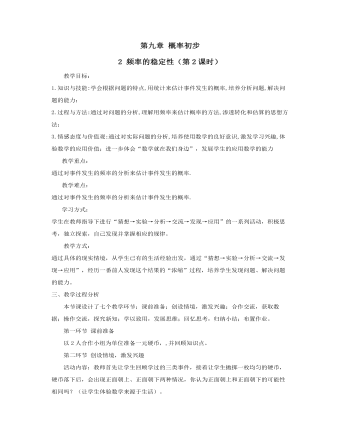
频率的稳定性教案教学设计
活动内容:教师首先让学生回顾学过的三类事件,接着让学生抛掷一枚均匀的硬币,硬币落下后,会出现正面朝上、正面朝下两种情况,你认为正面朝上和正面朝下的可能性相同吗?(让学生体验数学来源于生活)。活动目的:使学生回顾学过的三类事件,并由掷硬币游戏培养学生猜测游戏结果的能力,并从中初步体会猜测事件可能性。让学生体会猜测结果,这是很重要的一步,我们所学到的很多知识,都是先猜测,再经过多次的试验得出来的。而且由此引出猜测是需通过大量的实验来验证。这就是我们本节课要来研究的问题(自然引出课题)。

角平分线的性质教案教学设计
这是本节课的重点。让同学们将∠aob对折,再折出一个直角三角形(使第一条折痕为斜边),然后展开,请同学们观察并思考:后折叠的二条折痕的交点在什么地方?这两条折痕与角的两边有什么位置关系?这两条折痕在数量上有什么关系?这时有的同学会说:“角的平分线上的点到角的两边的距离相等”.即得到了角平分线的性质定理的猜想。接着我会让同学们理论证明,并转化为符号语言,注意分清题设和结论。有的同学会用全等三角形的判定定理aas证明,从而证明了猜想得到了角平分线的性质定理。
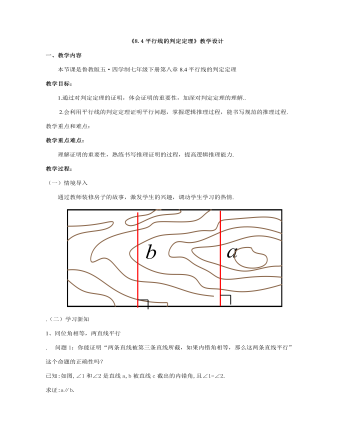
平行线的判定定理教案教学设计
问题1:你能证明“两条直线被第三条直线所截,如果内错角相等,那么这两条直线平行”这个命题的正确性吗?已知:如图,∠1和∠2是直线a,b被直线c截出的内错角,且∠1=∠2.求证:a∥b. 问题2:你能证明“两条直线被第三条直线所截,如果同旁内角互补,那么这两条直线平行”这个命题的正确性吗?已知:如图,∠1和∠2是直线a、b被直线c截出的同旁内角,且∠1与∠2互补.求证:a∥b
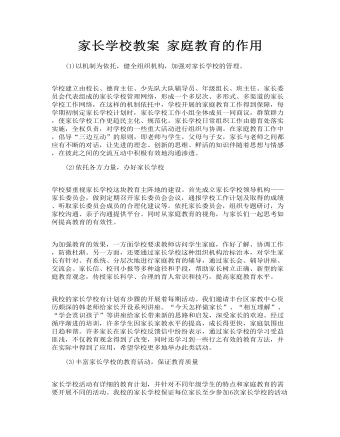
家长学校教案 家庭教育的作用
(2)依托各方力量,办好家长学校 学校要重视家长学校这块教育主阵地的建设。首先成立家长学校领导机构——家长委员会,做到定期召开家长委员会会议,通报学校工作计划及取得的成绩、听取家长委员会成员的合理化建议等。依托家长委员会,组织专题研讨,为家校沟通、亲子沟通提供平台。同时从家庭教育的视角,与家长们一起思考如何提高教育的有效性。 为加强教育的效果,一方面学校要求教师访问学生家庭,作好了解、协调工作,防微杜渐。另一方面,还要通过家长学校这种组织机构治标治本,对学生家长有针对、有系统、分层次地进行家庭教育的辅导,通过家长会、辅导讲座、交流会、家长信、校刊小报等多种途径和手段,帮助家长树立正确、新型的家庭教育观念,传授家长科学、合理的育人常识和技巧,提高家庭教育水平。
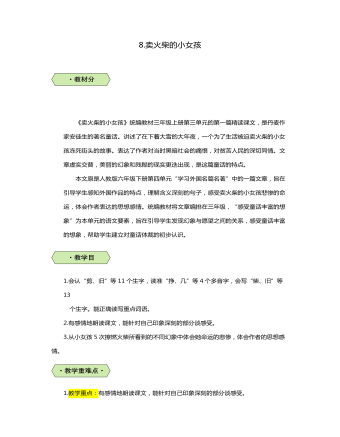
三年级语文卖火柴的小女孩教案
《卖火柴的小女孩》统编教材三年级上册第三单元的第一篇精读课文,是丹麦作家安徒生的著名童话。讲述了在下着大雪的大年夜,一个为了生活被迫卖火柴的小女孩冻死街头的故事。表达了作者对当时黑暗社会的痛恨,对贫苦人民的深切同情。文章虚实交替,美丽的幻象和残酷的现实更迭出现,是这篇童话的特点。本文原是人教版六年级下册第四单元“学习外国名篇名著”中的一篇文章,旨在引导学生感知外国作品的特点,理解含义深刻的句子,感受卖火柴的小女孩悲惨的命运,体会作者表达的思想感情。统编教材将文章编排在三年级,“感受童话丰富的想象”为本单元的语文要素,旨在引导学生发现幻象与愿望之间的关系,感受童话丰富的想象,帮助学生建立对童话体裁的初步认识。
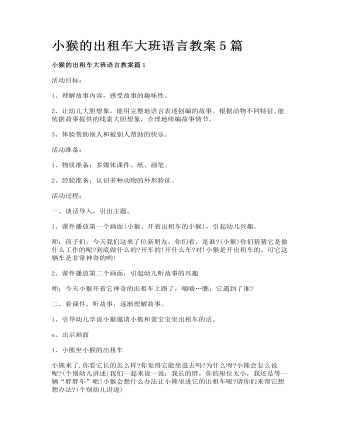
小猴的出租车大班语言教案5篇
1、讲述故事,加深理解。教师操作教具,讲述故事,穿插提问:a小猴发现蛋宝宝和小熊遇到什么困难?如果你是小猴你会怎样解决这个问题?请小朋友积极想办法。b小朋友听故事里的小猴是怎样做的。乘客对小猴设计的出租车是否“满意”(出示字卡满意),为什么?你们喜欢小猴和它的出租车吗?是否也“满意”?2、大胆想象仿编故事。引发仿编兴趣:小猴的名气越来越大了,森林里的小动物都来坐它的出租车。提问:长颈鹿和小刺猬遇到了什么困难?小猴是怎样解决的?森林里还有谁也乘坐小猴的出租车?他们可能遇到什么困难?小猴能解决吗?我们也帮小猴想想让所有的小动物都能顺利的乘坐出租车。(幼儿分组讨论,仿编故事,鼓励幼儿把故事讲给大家听。)
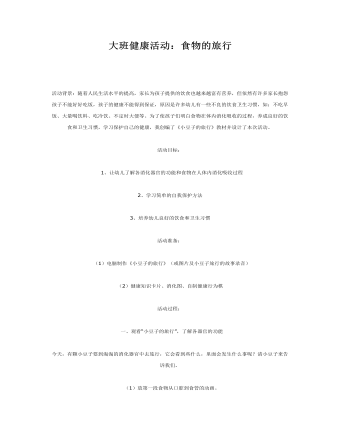
大班健康活动:食物的旅行教案
活动目标: 1、让幼儿了解各消化器官的功能和食物在人体内消化吸收过程2、学习简单的自我保护方法3、培养幼儿良好的饮食和卫生习惯活动准备: (1)电脑制作《小豆子的旅行》(或图片及小豆子旅行的故事录音)(2)健康知识卡片、消化图、自制健康行为棋活动过程:
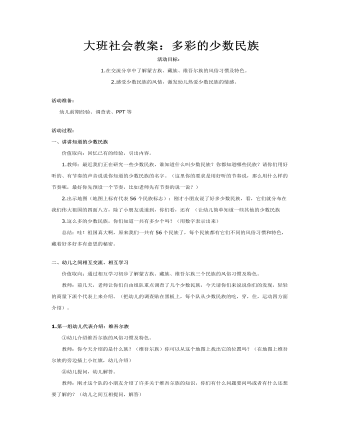
大班社会教案:多彩的少数民族
活动准备: 幼儿前期经验、调查表、PPT等活动过程:一、讲讲知道的少数民族 价值取向:回忆已有的经验,引出内容。1.教师:最近我们正在研究一些少数民族,谁知道什么叫少数民族?你都知道哪些民族?请你们用好听的、有节奏的声音说说你知道的少数民族的名字。(这里你的要求是用好听的节奏说,那么用什么样的节奏呢,最好你先预设一个节奏,比如老师先有节奏的说一说?)2.出示地图(地图上标有代表56个民族标志):刚才小朋友说了好多少数民族,看,它们就分布在我们伟大祖国的四面八方,除了小朋友说道到,你们看,还有(让幼儿简单知道一些其他的少数民族3.这么多的少数民族,你们知道一共有多少个吗?(用数字表示出来) 总结:哇!祖国真大啊,原来我们一共有56个民族了,每个民族都有它们不同的风俗习惯和特色,藏着好多好多有意思的秘密。
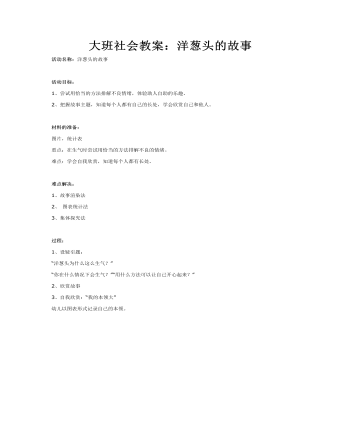
大班社会教案:洋葱头的故事
活动目标:1、尝试用恰当的方法排解不良情绪,体验助人自助的乐趣。2、把握故事主题,知道每个人都有自己的长处,学会欣赏自己和他人。 材料的准备:图片,统计表重点:在生气时尝试用恰当的方法排解不良的情绪。难点:学会自我欣赏,知道每个人都有长处。
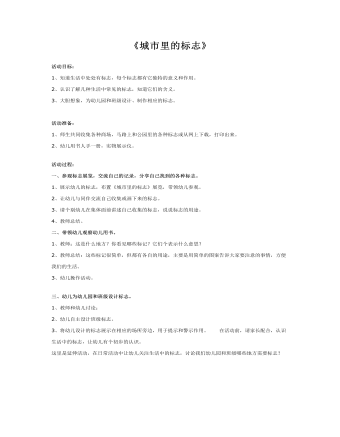
幼儿园大班社会教案:城市的标记
活动准备:1、师生共同收集各种商场,马路上和公园里的各种标志或从网上下载,打印出来。2、幼儿用书人手一册,实物展示仪。活动过程:一、参观标志展览,交流自己的记录,分享自己找到的各种标志。1、展示幼儿的标志,布置《城市里的标志》展览,带领幼儿参观。2、让幼儿与同伴交流自己收集或画下来的标志。3、请个别幼儿在集体面前讲述自己收集的标志,说说标志的用途。4、教师总结。
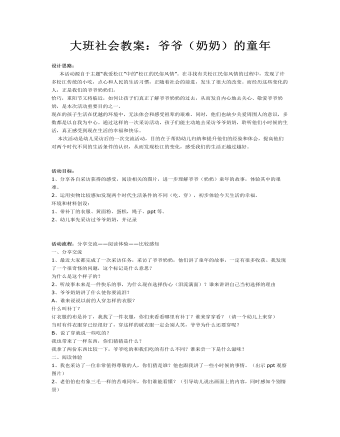
大班社会教案:爷爷(奶奶)的童年
活动目标:1、分享各自采访获得的感受,阅读相关的图片,进一步理解爷爷(奶奶)童年的故事,体验其中的艰难。2、运用实物比较感知发现两个时代生活条件的不同(吃、穿),初步体验今天生活的幸福。环境和材料创设:1、带补丁的衣服、黄面粉、蛋糕,绳子、ppt等。2、幼儿事先采访过爷爷奶奶,并记录
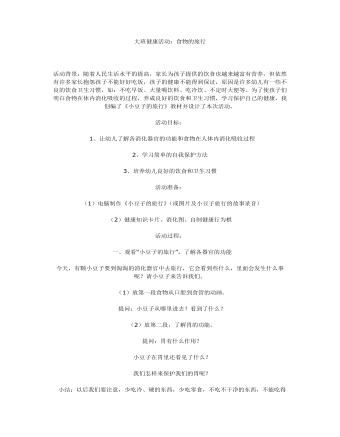
食物的旅行教案(大班健康活动)
1、让幼儿了解各消化器官的功能和食物在人体内消化吸收过程2、学习简单的自我保护方法3、培养幼儿良好的饮食和卫生习惯活动准备: (1)电脑制作《小豆子的旅行》(或图片及小豆子旅行的故事录音)(2)健康知识卡片、消化图、自制健康行为棋活动过程: